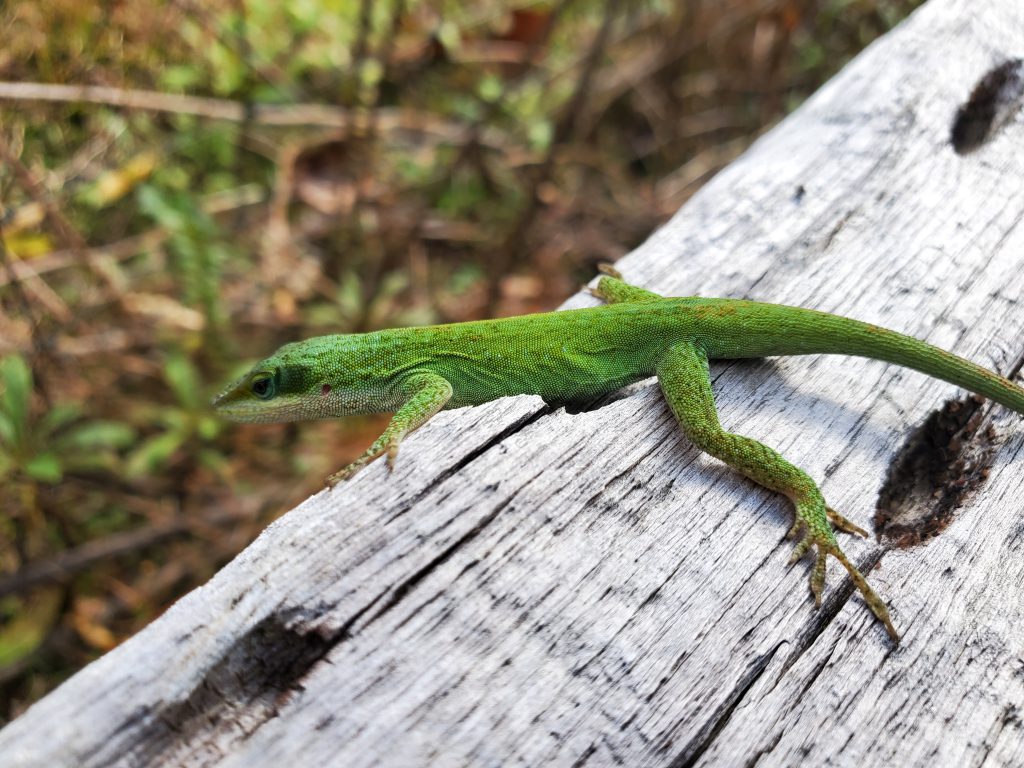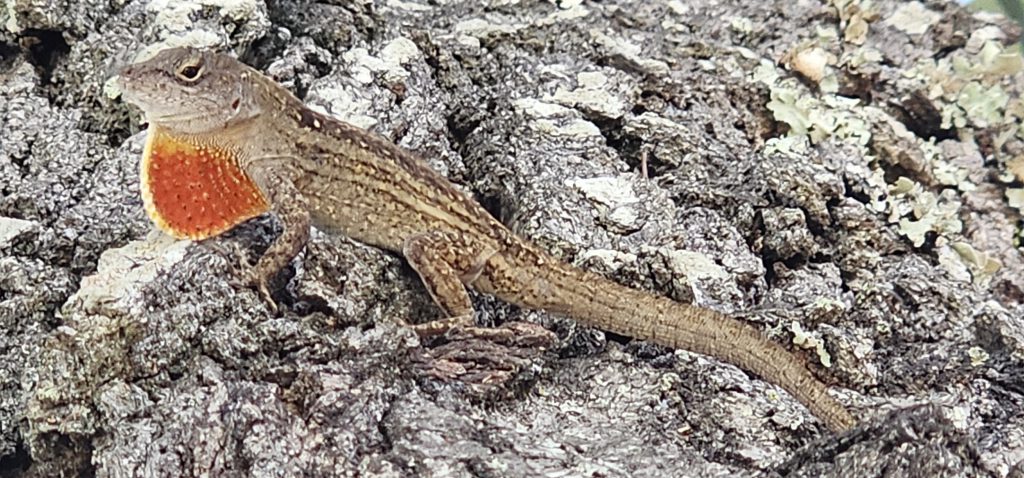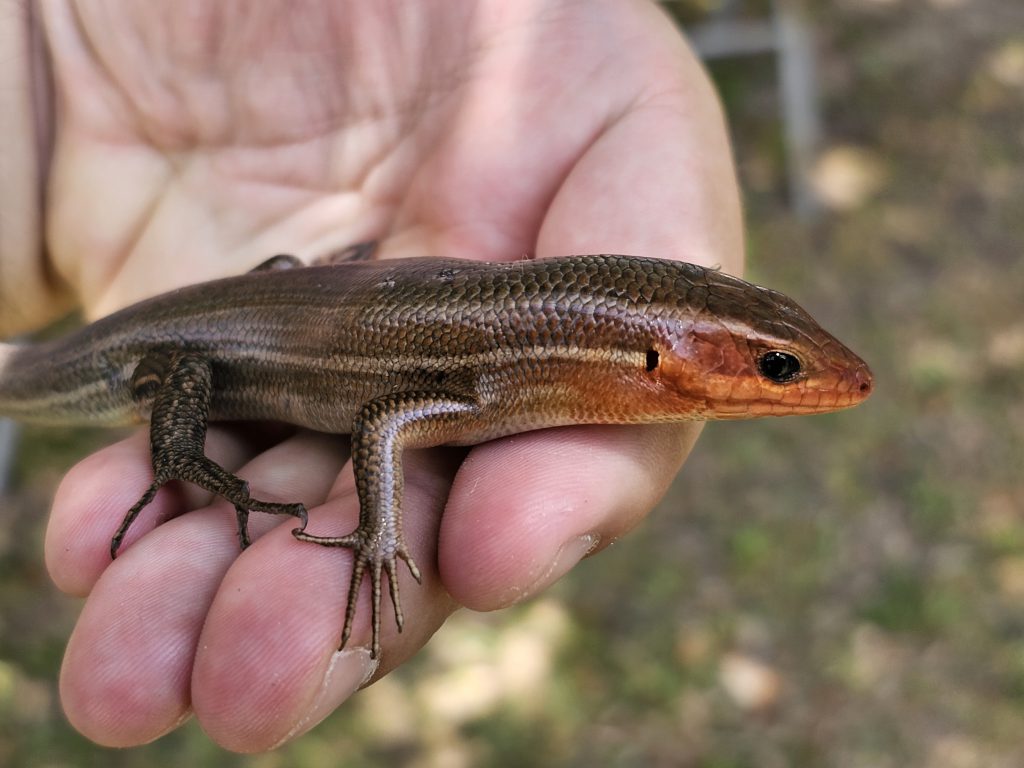Anyone spending any time outdoors in the Florida panhandle is bound to come across some of our local scaly residents before too long. With our high temperatures, high humidity, and high number of insects, we have a great climate for numerous reptiles to survive in. Some are native, some are not, and it can help to learn a little about them to understand the ecology we live in.
Here are some of the most common lizards you’ll see in our area:
Anoles
One of the most commonly seen lizards around, the green anole (Anolis carolinensis), is native to Florida. While it is named ‘green’, it is able to change color from green to brown. Despite this ability to camouflage themselves, they are not related to chameleons. Often active during the day, they eat a wide range of insects and other arthropods. Males can often be seen doing push-ups and flashing their dewlaps (colorful neck-flaps) as either a deterrent to predators or to attract a mate. This species favors living in trees, but can be found almost anywhere. These and many other lizards have the ability to lose their tails when pursued by predators. The tail may continue to move for some time after it detaches, which can serve as a distraction while the lizard itself flees from danger. The tail will regrow over a period of time.

A similar species is threatening our native populations of anoles. The brown anole (Anolis sagrei), also known as the Cuban brown anole, is highly invasive. They differ from the green anole in that they cannot change color, and often display a bold pattern on their skin. Introduced to the United States as stowaways on ships in the late 1800s, they compete with native species for food and sometimes even eat young green anoles. Brown anoles are typically found near the coast in the panhandle. While control of this invasive species is probably impossible at this point, you can help to avoid spreading them by cleaning equipment they may hide in (trailers or boats, for example) before transporting it, and inspecting ornamental plants for hidden anoles before moving them.

Skinks
At least two species of skinks share our habitat, the five-lined skink (Plestiodon fasciatus) and the broadhead skink (Plestiodon laticeps). The five-lined skink is mostly black with colorful accents, usually having a reddish head and blue tail. White or off-white stripes run lengthwise down their body. They are found in almost any habitat, and eat insects and other arthropods. The blue tail does not indicate any ability to sting, despite some local folklore.

The broadhead skink is one of the largest lizards in the area, growing up to a foot in length. Colored similarly to the five-lined skink, mature males fade in color and develop large, reddish heads with powerful jaws. They use these jaws to eat insects, invertebrates, and probably other small animals as well. Broadhead skinks prefer living in trees, but can be seen on the ground occasionally as well.
Fence Lizards
Sceloporus undulatus, the eastern fence lizard, loves dry, open woodlands. They often flee for higher ground when scared, climbing trees, stumps, or fences for protection from predators. Fence lizards have rough scales, usually patterened along their backs, with males sometimes displaying blue patches on their undersides. They, like other lizards, eat insects.
Geckos
Not native but commonly seen, the Mediterranean gecko (Hemidactylus turcicus) is a nocturnal species that is found throughout Florida. Urban and suburban locations are their favored habitats. They are often attracted to artificial lights at night, or rather the insects that themselves are attracted to the lights. Mediterranean geckos are usually pale in coloration, with almost translucent white or grey skin. They have large eyes with slit pupils and wide pads on their feet, which help them stick to smooth surfaces.
Glass Lizards
Upon first sight, one might be forgiven for thinking that a this species is actually a snake. It is not. Ophisaurus ventralis, the Eastern glass lizard, is a species of legless lizard that can grow to more than three feet in length. They hunt for insects to eat during the day, but are shy and will quickly try to hide if confronted. They are quick to shed their tails when in danger from predators; their name refers to their being perceived as brittle and breaking easily, like glass. They are not venomous, and their jaws are not powerful enough to break human skin.
- The Eastern Lubber Grasshopper - June 5, 2025
- Grass is Growing; Time for Mowing - April 30, 2025
- Variegation, Viruses, and You - June 27, 2024
